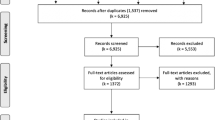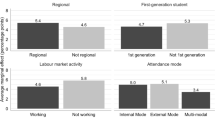Abstract
Economic recessions impact higher education institutions in complex ways. Several analyses have examined the influence of the 2007–2009 recession on tuition, enrollments, revenues, and expenditures, but the connection of these resource allocation patterns to a student success outcome—namely, retention—is limited. This study examined relationships among institutional expenditures, tuition, and staffing patterns on first-year retention rates at private and public institutions in 2007, 2009 and 2011: before, during, and after the economic recession. Private and public institutions increased tuition during this time period and increased expenditures. Expenditures most directly educating students (i.e. instruction) and institutional selectivity were positively associated with retention. However, public and private institutions differed in how they allocated their expenditures. That the findings correspond with past research investigating relationships between resource allocation and retention illustrate principles of the resource dependency theory (Pfeffer and Salancik 1978): institutions impacted by external economic changes, adjust revenues, staffing, and expenditures during economic changes.
Similar content being viewed by others
References
Abouzeida, E. (2014). Analysis of expenditure patterns in higher education institutions and student graduation and retention rates (Doctoral dissertation, Auburn University). Retrieved from https://etd.auburn.edu/bitstream/handle/10415/4223/Essam%20Abouzeida_PhD_Dissertation_final%20draft.pdf?sequence=2&ts=1424657519844
Agresti, A., & Finlay, B. (2008). Statistical methods for the social sciences (4th ed.). London: Pearson.
Altbach, P. G., & Finkelstein, M. J. (2015). The crisis of the American academic workforce. International Higher Education 52. Retrieved from https://ejournals.bc.edu/ojs/index.php/ihe/article/viewFile/8035/7186
American Association of Community Colleges (AACC). (n.d.). Fast facts. Retrieved from http://www.aacc.nche.edu/AboutCC/Pages/fastfactsfactsheet.aspx
Archibald, R. B., & Feldman, D. H. (2008). Explaining increases in higher education costs. The Journal of Higher Education, 79(3), 268–295.
Barr, A., & Turner, S. E. (2013). Expanding enrollments and contracting state budgets: The effect of the Great Recession on higher education. The Annals of the American Academy of Political Science, 650(1), 168–193. doi:10.1177/0002716213500035.
Barron’s Educational Series. (2009). Barron’s profiles of American Colleges of 2009. Hauppauge, NY: Barron’s Educational Series.
Blumenstyk, G., Lambert, L., & Supiano, B. (2015, April 10). The decreasing affordability of public flagships, in one chart. The Chronicle of Higher Education 61(30), p. A28–A28. Retrieved from http://www.chronicle.com
Bowen, H. R. (1980). The costs of higher education: How much do colleges and universities spend per student and how much should they spend?. San Francisco, CA: Jossey-Bass.
Bowen, W. G., Chingos, M. M., & McPherson, M. S. (2009). Crossing the finish line: Completing college at America’s public universities. Princeton, NJ: Princeton University Press.
Brown, J. R., & Hoxby, C. M. (Eds.). (2014). How the financial crisis and great recession affected higher education. Chicago, IL: University of Chicago Press.
Caldwell, T. (2012, February 15). Current college students struggle to survive rising tuitions. The New York Times. Retrieved from http://thechoice.blogs.nytimes.com/2012/02/15/current-college-students-struggle-to-survive-rising-tuitions/?_r=1
Carey, K. (2012). The siege of academe. Retrieved from Washington Monthly http://washingtonmonthly.com/magazine/septoct-2012/the-siege-of-academe/
Carnevale, A. P., & Rose, S. J. (2003). Socioeconomic status, race/ethnicity, and selective college admissions. New York, NY: Century Foundation.
Clotfelter, C. T. (2014). Buying the best: Cost escalation in elite higher education. Princeton, NJ: Princeton University Press.
Douglas, J. A. (2010). Higher education budgets and the global recession: Tracking varied national responses and their consequences. Retrieved from University of California, Berkeley, Center for Studies in Higher Education website: http://escholarship.org/uc/item/44m4p8r4#page-1
Dunbar, A., Hossler, D., Shapiro, D., Chen, J., Martin, S., Torres, V. & Ziskin, M. (2011). National postsecondary enrollment trends before, during, and after the Great Recession. Retrieved from National Student Clearinghouse Research Center website: http://www.studentclearinghouse.info/signature/1/NSC_Signature_Report_1.pdf
Dyke, F. L. (2000). Understanding expenditure data. New Directions for Institutional Research, 106, 19–30.
Ehrenberg, R. G., & Zhang, L. (2005). Do tenured and tenure-track faculty matter? Journal of Human Resources, 40(3), 647–659.
Fowles, J. (2014). Funding and focus: Resource dependence in public higher education. Research in Higher Education, 55(3), 272–287. doi:10.1007/s11162-013-9311-x.
Fry, R (2009). College enrollment hits all-time high, fueled by community college surge. Pew Research Center. Retrieved April 27, 2015 from http://pewsocialtrends.org/files/2010/10/college-enrollment.pdf
Gansemer-Topf, A. (2004). Investing in student persistence: A regression analysis of institutional expenditure patterns and retention and graduation rates at private baccalaureate colleges and universities (Doctoral dissertation). Available from ProQuest Dissertations & Theses database (UMI NO. 3136313).
Gansemer-Topf, A. M., & Schuh, J. H. (2003). Instruction and academic support expenditures: An investment in retention and graduation. Journal of College Student Retention, 5(2), 135–145.
Gansemer-Topf, A. M., & Schuh, J. H. (2006). Institutional selectivity and institutional expenditures: Examining organizational factors that contribute to retention and graduation. Research in Higher Education, 47(6), 613–642.
Geiger, R. (2015). Impact of the financial crisis on higher education in the United States. International Higher Education 59. Retrieved from http://ejournals.bc.edu/ojs/index.php/ihe/article/view/8486
Gelman, A., Carlin, J. B., Stern, H. S., Rubin, D. B., Dunson, D. B., Vehtari, A., et al. (2014). Bayesian data analysis (3rd ed.). Boca Raton, FL: Chapman & Hall/CRC.
Hiltonsmith, R., & Draut, T. (2014). The great cost shift continues: State higher education funding after the recession. Demos. Retrieved from http://www.demos.org/publication/great-cost-shift-continues-state-higher-education-funding-after-recession
Hossler, D. (2004). Refinancing public universities: Student enrollment, incentive-based budgeting, and incremental revenue. In E. P. St. John & M. D. Parsons (Eds.), Public funding of higher education: Changing contexts and new rationales (pp. 145–163). Baltimore: Johns Hopkins University Press.
Hurwitz, M. & Kumar, A. (2015). Supply and demand in the higher education market: College enrollment. College admission and college choice (Research brief). Retrieved from College Board website: http://files.eric.ed.gov/fulltext/ED562848.pdf
Jaquette, O. (2013). Why do colleges become universities? Mission drift and the enrollment economy. Research in Higher Education, 54(5), 514–543.
Johnson, N. (2014). College costs, prices and the Great Recession. Retrieved from http://files.eric.ed.gov/fulltext/ED555862.pdf
Kelderman, E. (2011). Recession pushed state and local higher-ed spending to 25-year low in 2010. Inside Higher Ed. Retrieved Feb. 24, 2014, from https://chronicle.com/article/Recession-Pushed-State-and/126647/.
Kirshstein, R. J., & Hurlbut, S. (2012). Revenues: Where does the money come from?: A Delta data update, 2000–2010. Washington, D.C.: American Institutes for Research. Retrieved from http://files.eric.ed.gov/fulltext/ED536132.pdf
Looney, A. & Yannelis, C. (2015). A crisis in student loans? How changes in the characteristics of borrowers and in the institutions they attended contributed to rising student loan defaults. (Brookings Papers on Economic Activity). Retrieved from Brookings Institute website: http://www.brookings.edu/~/media/projects/bpea/fall-2015_embargoed/conferencedraft_looneyyannelis_studentloandefaults.pdf
Martin, J. P. (2012). Tuition discounting through unfunded institutional aid at private baccalaureate colleges (Doctoral dissertation). Retrieved from ProQuest Dissertations & Theses database. (Publication No. 3514841)
Martin, R. E., & Hill, R. C. (2014). Baumol and Bowen cost effects in research universities. Retrieved from Social Science Research Network: http://ssrn.com/abstract=2153122
Mendenhall, W., Sincich, T., & Boudreau, N. S. (1996). A second course in statistics: Regression analysis (Vol. 5). Upper Saddle River, NJ: Prentice Hall.
Mertler, C. A., & Vanatta, R. A. (2010). Advanced and multivariate statistical methods (4th ed.). Glendale, CA; Pyrczak.
National Association of College and University Business Officers (NACUBO). (2015). 2014 tuition discounting study. Washington, DC: NACUBO.
National Association of State Budget Officers (NASBO). (2015). Summary: NASBO state expenditures report. Retrieved from NASBO website: http://www.nasbo.org/sites/default/files/Summary_State%20Expenditure%20Report.pdf
National Association of College and University Business Officers (NACUBO). (n.d.). The financial downturn and its impact on higher education institutions. Retrieved from NACUBO website: http://www.nacubo.org/documents/Impact%20of%20the%20Economy%20on%20Higher%20Education.pdf
National Bureau of Economic Research (NBER). (n.d.). The NBER’s business cycle dating procedure: Frequently asked questions. Retrieved from http://www.nber.org/cycles/recessions_faq.html
National Center for Education Statistics (NCES). (2013). Integrated Postsecondary Education Data System, 2013. [Data file]. Retrieved from National Center for Education Statistics site, https://nces.ed.gov/ipeds/
Nelson, L.A. (2013, February 13). On notice, again. Inside Higher Ed. Retrieved from https://www.insidehighered.com/news/2013/02/13/obama-calls-more-attention-price-value-accreditation-state-union
Oehlert, G. W. (2000). A first course in design and analysis of experiments. New York, NY: W.H. Freeman.
Oliff, P., Palacios, V., Johnson, I., & Leachman, M. (2013). Recent deep state higher education cuts may harm students and the economy for years to come. Retrieved from Center on Budget and Policy Priorities website: http://www.cbpp.org/sites/default/files/atoms/files/3-19-13sfp.pdf
Pfeffer, J., & Salancik, G. R. (1978). The external control of organizations: A resource dependence perspective. New York, NY: Harper and Row.
Pike, G. R., Kuh, G. D., McCormick, A. C., Ethington, C. A., & Smart, J. C. (2011). If and when money matters: The relationships among educational expenditures, student engagement, and students’ learning outcomes. Research in Higher Education, 52, 81–106.
Powell, B. A., Gilleland, D. S., & Pearson, L. C. (2012). Expenditures, efficiency, and effectiveness in U.S. undergraduate higher education: A national benchmark model. Journal of Higher Education, 83(1), 102–127.
Powell, K. K., & Rey, M. P. (2015). Exploring a resource dependency perspective as an organizational strategy for building resource capacity: Implications for public higher education universities. Management in Education, 29(3), 94–99. doi:10.1177/0892020615586805.
Rabovsky, T. M. (2012). Accountability in higher education: Exploring impacts on state budgets and institutional spending patterns. Journal of Public Administration Research and Theory, 22, 675–700. doi:10.1093/jopart/mur069.
Ryan, J. F. (2004). The relationship between institutional expenditures and degree attainment at baccalaureate colleges. Research in Higher Education, 45(2), 97–114.
Ryan, J. F. (2005). Institutional expenditures and student engagement: A role for financial resources in enhancing student learning and development? Research in Higher Education, 46(2), 235–249.
Sala, L., Söderstrom, U., & Trigari, A. (2012, August). Structural and cyclical forces in the labor market during the Great Recession: cross-country evidence. In NBER International Seminar on Macroeconomics 2012 (pp. 345–404). Chicago, IL: University of Chicago Press.
Selingo, J. J. (2013, April 12). Colleges struggling to stay afloat. The New York Times. Retrieved from http://www.nytimes.com
Shin, J. C. (2010). Impacts of performance-based accountability on institutional performance in the U.S. Higher Education, 60, 47–68. doi:10.1007/s10734-009-9285-y.
Slaughter, S., & Rhoades, G. (2004). Academic capitalism and the new economy: Markets, state, and higher education. Baltimore, MD: The Johns Hopkins University Press.
Tabachnick, B. G., & Fidell, L. S. (2001). Using multivariate statistics (4th ed.). Boston, MA: Allyn & Bacon.
The Institution for College Access and Success (TICAS). (n.d.). Project on student debt. Retrieved from http://ticas.org/posd/map-state-data-2015
Titus, M. A. (2006). Understanding the influence of the financial context of institutions on student persistence at four-year colleges and universities. The Journal of Higher Education, 77(2), 353–375.
Turner, S. E. (2014). The impact of the financial crisis on faculty labor markets. In C. M. Hoxby & J. R. Brown (Eds.), How the financial crisis and Great Recession affected higher education (pp. 175–207). Chicago: University of Chicago Press.
Webb, J. C. (2014). The impact of revenue diversification on the financial and educational outcomes of private colleges and universities during the Great Recession (Doctoral dissertation, University of Michigan). Retrieved from http://deepblue.lib.umich.edu/bitstream/handle/2027.42/107145/jwebbtx_1.pdf?sequence=1&isAllowed=y
Webber, D. A., & Ehrenburg, R. G. (2010). Do expenditures other than instructional expenditures affect graduation and persistence rates in American higher education. [Electronic version]. Retrieved Feb. 24, 2014, from Cornell University, School of Industrial and Labor Relations site: http://digitalcommons.ilr.cornell.edu/workingpapers/129.
Ziskin, M., Hossler, D., & Kim, S. Y. (2009). The study of institutional practices related to student persistence. Journal of College Student Retention, 11(1), 101–121.
Zumeta, W. (2010). The great recession: Implications for higher education. National Education Association 2010 Almanac of Higher Education. Retrieved from http://m.isea.org/assets/img/PubAlmanac/Zumeta_2010.pdf
Author information
Authors and Affiliations
Corresponding author
Rights and permissions
About this article
Cite this article
Gansemer-Topf, A.M., Downey, J., Thompson, K. et al. Did the Recession Impact Student Success? Relationships of Finances, Staffing and Institutional Type on Retention. Res High Educ 59, 174–197 (2018). https://doi.org/10.1007/s11162-017-9462-2
Received:
Published:
Issue Date:
DOI: https://doi.org/10.1007/s11162-017-9462-2




